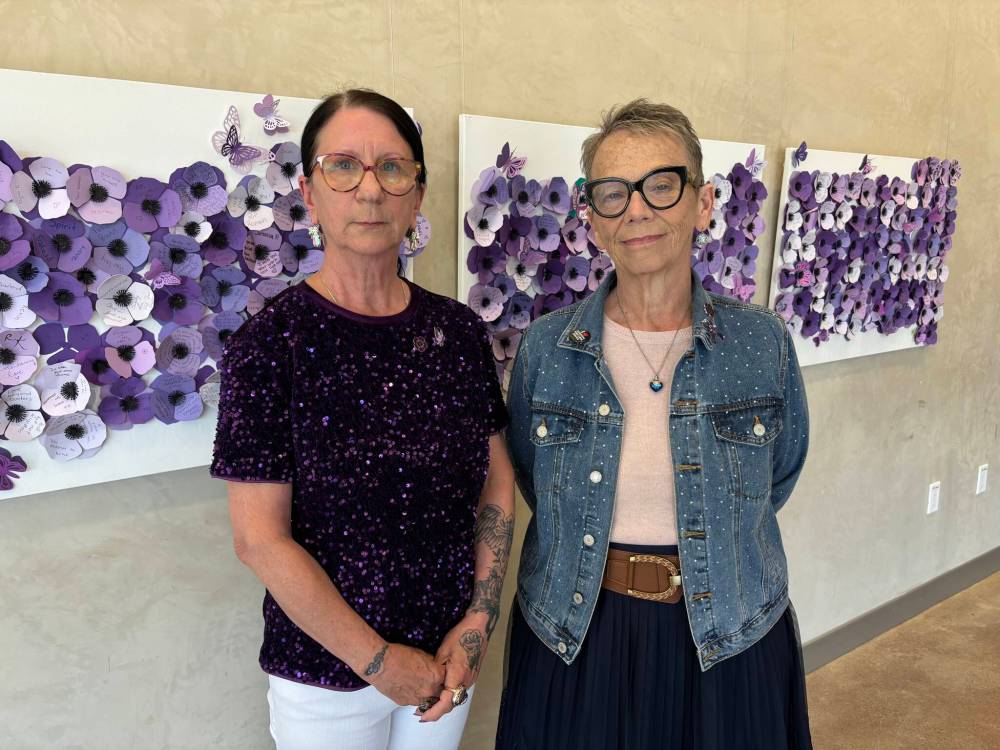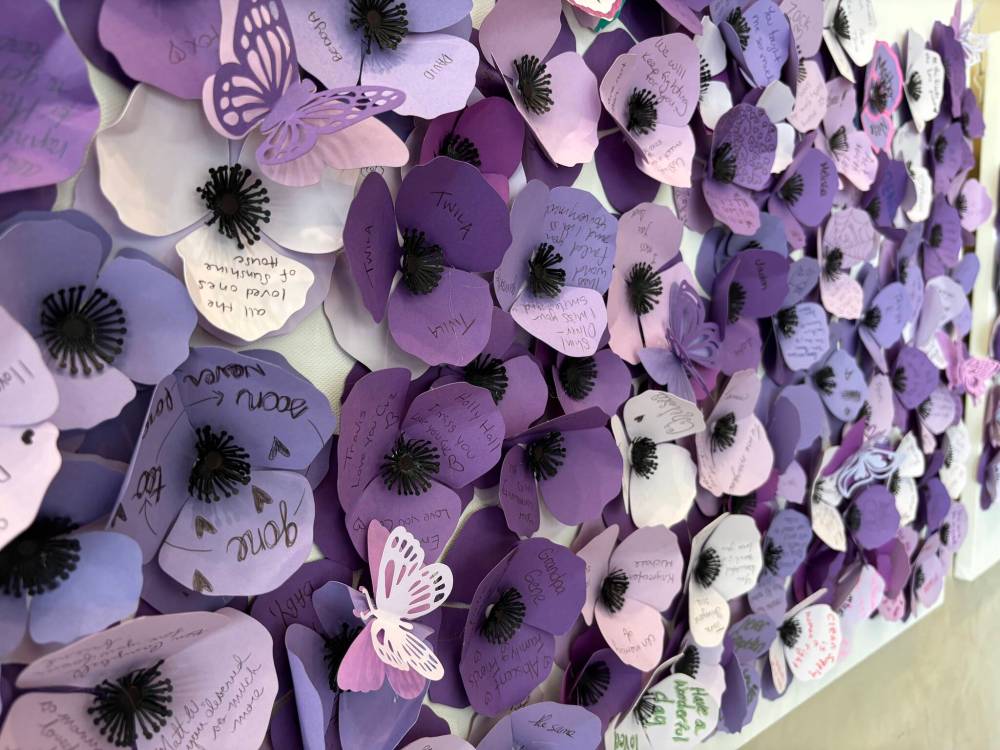Two harm-reduction advocates are hoping a river of purple poppies catches politicians’ attention.
Arlene Last-Kolb and Janis Gillam are the creators of “Gone Too Soon,” an art installation currently on display at the Canadian Museum for Human Rights. The river of paper poppies represents the thousands of people who have died as a result of substance use.

AARON EPP / FREE PRESS
Arlene Last-Kolb and Janis Gillam are the creators of “Gone Too Soon,” an art installation currently on display at the Canadian Museum for Human Rights.
The installation is more than a tribute, according to Last-Kolb. She and Gillam view the image as a river flowing to Ottawa, and they hope it sends a message to government officials and policy-makers that the public needs access to a regulated, safer drug supply.
Both women have lost children who overdosed on drugs laced with fentanyl: Last-Kolb’s son, Jessie, died in 2014 at age 24; Gillam’s daughter, Phoebe, was 31 when she died in 2020.
“We want our loved ones to be seen and to be remembered, and we want them to be part of change,” Last-Kolb said.
The purple poppies include messages written by community members to their loved ones. They were created at a national harm reduction conference in November 2022 that was held in Manitoba, and at the Winnipeg Harm Reduction Network’s annual planning meeting this past April.
Last-Kolb and Gillam were at the museum on Saturday for Overdose Awareness Day. Members of the public were invited to write messages on poppies that will be added to the installation.
“We wanted to open it up to the public so that as many people as possible could come down and do this and honour their loved ones,” Last-Kolb said.
Substance use is a public health matter and not a moral failing, she and Gillam wrote in a piece of writing that accompanies the installation. However, people who use drugs are stigmatized and systemically mistreated.
They advocate for harm reduction methods such as safer supply initiatives and decriminalization.
“With the ways that our loved ones died, there’s so much stigma,” Last-Kolb told the Free Press. “What better way to cover stigma than with art — than with showing how we feel? Silence the stigma by showing love and care instead.”
Creating the installation came naturally to the two friends, both of whom have turned to making art and crafting as part of their grieving.
Jonny Mexico, Winnipeg co-ordinator for the Manitoba Harm Reduction Network, attended the event to educate attendees about responding to an opioid overdose, including how to use the opioid-overdose reversal drug naloxone.

AARON EPP / FREE PRESS
The purple poppies include messages written by community members to their loved ones.
The event caught the attention of Tina Kurtz of Saskatoon, who was visiting the museum on Saturday.
Responding to substance use in the community and keeping people safe has been a topic of discussion for Kurtz and her friends this past summer. Her teenage son has a friend who has struggled with substance use.
“It’s everywhere,” the 53-year-old said. “You see it whether it’s in your friend group or around you.”
Kurtz appreciated the information Mexico provided. “(It) answered all my questions.”
Kurtz’s daughter, Olivia, who moved to Winnipeg recently for graduate studies at the University of Manitoba, was also grateful for the demonstration. Knowing how to use naloxone might come in handy if she’s at the bar with friends and she encounters someone in trouble.
“Just having this on hand, you might be able to be a part of a solution and save somebody’s life,” the 22-year-old said.
Mexico was pleased to speak with attendees.
“There’s very rarely someone I talk to who hasn’t been impacted by someone they know, someone that they love, using substances,” Mexico said. “I think the more we’re able to talk about that, and demystify and destigmatize it, the better.”
According to the Government of Canada, a total of 44,592 apparent opioid toxicity deaths were reported between January 2016 and December 2023.
In Manitoba, drug-related deaths reached a near-record high of 53 in April, the most recent preliminary numbers provided by the Office of the Chief Medical Examiner show. That’s up from 29 in March and 33 in February. It is the highest monthly number since 57 deaths were reported in August 2021.
“Gone Too Soon” is on display in the museum’s community corridor, a platform for community members to share their work, until December.
aaron.epp@freepress.mb.ca

Aaron Epp
Reporter
Aaron Epp reports on business for the Free Press. After freelancing for the paper for a decade, he joined the staff full-time in 2024. He was previously the associate editor at Canadian Mennonite. Read more about Aaron.
Our newsroom depends on a growing audience of readers to power our journalism. If you are not a paid reader, please consider becoming a subscriber.
Our newsroom depends on its audience of readers to power our journalism. Thank you for your support.